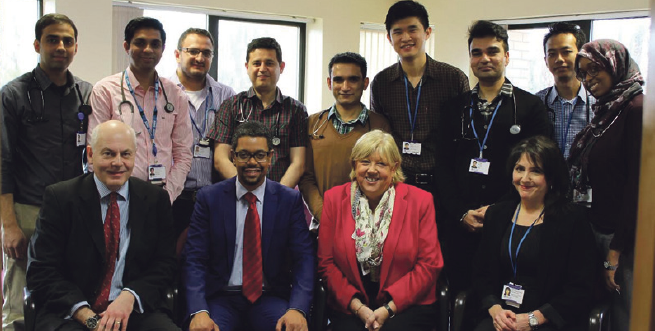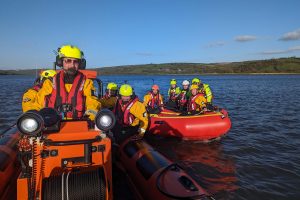
DEPUTY HEALTH MINISTER, Vaughan Gething AM, visited Withybush General Hospital on Monday (Feb 1), to meet Hywel Dda University Health Board staff and patients.
Mr Gething visited a new community-based eye care service which has reduced the journey time for hundreds of patients travelling some of the greatest distances in the UK to access eye care.
Patients in the HDUHB travel to one of two sites to access wet AMD services, either at Amman Valley Hospital, in Ammanford, or Bronglais Hospital, Aberystwyth.
Changes to eye services
For some patients in Pembrokeshire and south Ceredigion this has required return journeys in excess of 100 miles for review, and sometimes a second journey for treatment (injection).
Vaughan Gething said: “I’m pleased to see how the £400,000 investment from the Welsh Government is making it easier for people to get treatment for wet AMD closer to their homes – this is an example of the NHS providing the right care, in the right place, at the right time.”
Consultant Ophthalmologist Mr Richard Wintle responded: “This project will improve the quality of life for approximately 340 patients, often elderly and vulnerable, currently experiencing a significant travel burden. It will also release some capacity within our whole service, allowing us to treat more people who are waiting for care and improve patient outcomes.”
Minister meets new doctors
During his visit the Deputy Minister met with some of the international doctors have now been employed directly by HDUHB as clinical fellows to support the junior doctor rota and maintain emergency and medical services at the hospital for the Pembrokeshire population.
They have been provided with a two-year training scheme which mirrors many elements of the traditional core medical training (CMT) scheme for junior doctors in the UK after Withybush Hospital was not allocated any CMTs in August of this year.
The training programme offered by HDUHB is the first of its kind in Wales and aims to recruit doctors to rural hospitals in an environment of a shortage of junior doctors across the UK. As part of the scheme, the health board purchases an e-portfolio for each doctor to enable them to build their competencies and achieve qualifications just like other trainee doctors in the NHS.
Complex demands on ambulance service
We asked Mr Gething about the continuing and troubling lag in ambulance response times across the HDUHB area in general, and Pembrokeshire in particular.
The Minister told us: “The people of Pembrokeshire, and the same goes for everywhere else, are entitled to the same level of quality healthcare.
“However,” the Minister continued, “the demands placed on our emergency ambulance service are more complex than ever before and are growing yearon- year. It is clear if we are to meet these demands and ensure the best outcomes for patients, we need to transform the way in which we deliver emergency ambulance services.”
As to how that transformed service might be delivered, the Minister said: “The new clinical response model, which we will pilot in Wales, has been designed by Wales’ top ambulance service clinical leaders and is based on firm evidence. It is a move away from the system based solely on the eightminute response time target, which was introduced 42-years ago, to one which measures how successful our ambulance clinicians are in ensuring they have the most positive impact on clinical outcomes and people’s quality of life.”
But what about the crucial red call response times? “The system looks at every red call to find out establish the circumstances behind any delay: Whether the location is geographically remote, or whether a different sort of activity or first responder could deal with the call. The use of community first responders, not only paramedics, to get more quickly to incidents can be the difference between life and death.
“We take very seriously the responsibility to have appropriate response times for those who need it, that’s why we changed the model: it is about people who need a fast response.”
New models of rural healthcare
In relation to GP shortages and the continuing decline in general practice numbers, Mr Gething told us: “The shortage of GPs joining practice is a UKwide problem, and it is not only limited to Wales, or Hywel Dda.
The MInister continued: “We recognise the challenge, however, and need different models for what works and I am encouraged at the way we are finding ways of using different parts of the same workforce. Collaborative working with other professionals and innovative ways of delivering services make this area a more attractive one for GPs to come to.”
On that collaborative working, Vaughan Gething said: “I am pleased to see that Hywel Dda Health Board is working with Powys Health Board and other parts of Wales to find ways of more effectively using resources to deliver health care to people when and where we need it.
“We need to remember, however, that there are advantages to coming here to work. This is a fantastic place to live and GPs not only come to a place to work.”


















Add Comment